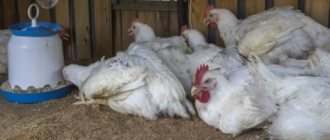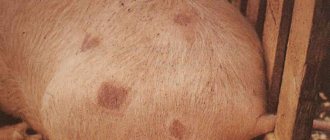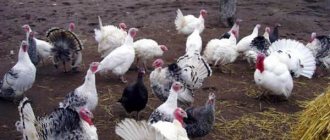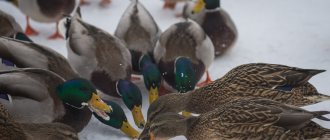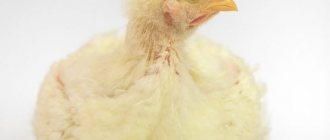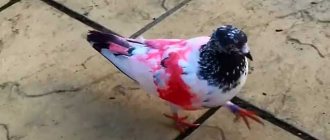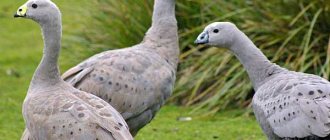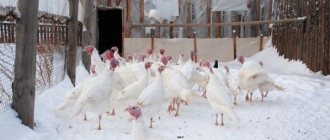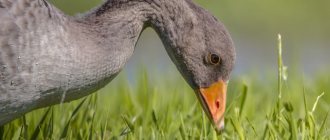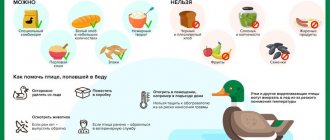What is a chicken louse: what does it eat and how does it reproduce?
The chicken louse, or feather eater, is the most common parasite found on farm and wild poultry. Scientists have identified more than five thousand varieties of lice, of which about two and a half thousand can parasitize birds. Twenty subspecies, each of which has its own characteristics, cause enormous damage to the agriculture of our country.
The chicken louse lives on both domestic and wild birds
Some bird lice are divided into two main families - lice eaters and feather eaters, but in a practical sense, such a division is not of great importance, since the specifics of parasitism of both, as well as the methods of combating them, are identical.
In addition to chickens, lice eaters can attack domestic and wild birds such as:
- goose,
- duck,
- quail,
- turkey,
- guinea fowl.
The parasite is very specific in its choice of prey; the bird louse does not live on mammals.
What does the lice eater look like and what does it eat?
Bird lice are small insects that do not have wings, with a rounded flat or elongated segmented body up to two millimeters long. The chicken parasite is distinguished by a yellowish-brown tint and individual dark elements. The insect has a wide head and poorly developed antennae. On each of the six legs, arranged in pairs, there are claw growths, with the help of which the insect can fix its position on the body of the victim.
The chicken louse diet includes:
- fluff,
- feather,
- poultry skin particles.
These creatures do not need blood, but they will not refuse its frozen elements on the edges of wounds formed as a result of scratching.
Leaf lice feed on feathers and down of birds
Reproduction
Females produce white eggs that adhere firmly to the feather or down of the bird. The eggs reach a length of one and a half millimeters, are oval in shape and are visible to the naked eye upon careful examination. The hatching process begins on the fifth to twentieth day, depending on conditions. The larvae, although similar to adults when visually examined, must go through the molting stage three times, and only then after two to three weeks they become sexually mature parasites. The reproduction of all avian pests is characterized by the highest speed and efficiency. The female brings up to one hundred thousand eggs during her life cycle. Poultry and feather eaters cannot survive outside the bird's body; they die already on the second or third day, once in the external environment.
Lice and lice
Chicken mallophages or chicken lice eaters are small insects that parasitize birds. They are keratophages and feed on the keratin of bird hair. Externally, lice and lice are very similar, which is why the people call lice “chicken louse”.
However, despite the external similarity, lice and lice differ in feeding habits. Lice feed mainly on blood, while lice eat feathers and down. In veterinary practice, infection of birds by lice eaters is called mallophagosis. This disease is quite often diagnosed in domestic chickens.
You can assume that a chicken has lice eaters based on the following signs:
- On physical examination of the bird, damage to the feathers at the root is observed.
- The chicken is acting very restless. She constantly tries to clean her feathers of parasites with her beak.
- If there are too many parasites, partial loss of feathers may occur.
If chickens are infected with lice beetles, their ability to lay eggs will be significantly reduced.
In addition, the birds will stop gaining weight or even begin to lose weight.
How to recognize lice in birds, symptoms of infection
Parasites can attack chickens of all ages, but the younger generation of birds suffers the most from them. Carnivores are carried by infected pets; pests can be found on care items and equipment. Lice can be found in nests, dust baths and cages. Their most active carriers are roosters, since they bathe little in sand and dust baths and are less likely to clean their plumage.
The number of infections typically increases sharply in the fall and spring. This is also facilitated by factors such as:
- chicken coop overpopulation,
- large crowd of birds,
- wrong content,
- insufficient care
- poor nutrition,
- dampness and dirt in the chickens' home.
Signs of the presence of lice eaters in a bird can be seen with the naked eye, these are, first of all:
- combing,
- baldness, most often in the back, neck, abdomen,
- holes in the feather
- bird anxiety, inappropriate behavior,
- pecking,
- feather plucking,
- abrasions and damage,
- inflammation of the eyes,
- poor egg production,
- weight loss.
Several types of pests can be present on one pet at once. Some lice eaters prefer to settle in the feather cover under the wings, others choose the neck and head. The chicken louse prefers young feathers, which is why the activity and number of parasites increases during the molting period. On the bare skin of a bird with severe infection, wounds that appear as a result of scratching, as well as parasite eggs, are clearly visible. Similar signs are observed on the earrings and comb of pets.
You can diagnose a periodontal infestation by carefully examining the bird.
Diagnosing the presence of a problem in chickens is quite easy. To do this, place the bird in the sun or under the light of an incandescent lamp. Within a few minutes, the parasites crawl into the heat and become clearly visible to the naked eye. Using this method, you can more or less accurately determine the extent of the infection. Dead chickens are not of interest to feather eaters, since for a comfortable existence it is important for them to have heat and a constant temperature of a certain level.
What do mallophages look like?
Chicken lice
It is not easy to see an insect with the naked eye, but you can look at the photo of chicken lice. The parasite is 1.5 - 2.5 mm long and brown in color. His head is slightly wider than his body. Lives on the skin. It lays eggs at the base of the feather.
The louse cannot move through the air, but it can jump high. It has a hard chitinous shell. It is capable of settling on any species of birds, but does not survive on mammals. Some poultry farmers mistakenly believe that chicken lice live on humans, mistaking fleas for mallophages.
Interesting!
The parasite can live without food for 2 to 5 days.
The louse is held on the chicken's body by three pairs of paws and strong jaws. The main food is blood. In addition to this, it consumes fluff, feathers, and skin flakes, causing severe itching.
The most common places where lice can live are:
- under the wings;
- around the anus;
- on the neck.
To detect mallophagosis at the initial stage, thermotropism is used - heating the chicken for 10 minutes. After this procedure, bird lice crawl onto the surface of the feather. To make a diagnosis, a veterinarian will take a scraping from a sick bird.
Consequences of infection
Chicken lice are dangerous parasites that can be carried by a wide variety of birds, including wild ones. The consequences of infection can be very dire, including mass death of chicken coop inhabitants.
As the number of feather eaters increases, the bird stops laying eggs, loses motor activity, and begins to develop health problems such as anemia and anemia. Usually this is followed by extreme exhaustion of the pet and death if proper measures are not taken.
The chicken louse is a carrier of many infections, including:
- brucellosis,
- salmonellosis,
- trypanosomiasis,
- plague,
- encephalitis.
Bird parasites also carry helminth eggs, which can infect humans upon contact with a chicken. Due to the above factors, when chickens are massively infected with periodontal beetles, eating their meat and eggs is strongly discouraged.
Symptoms
The presence of chicken lice is a very serious disease for poultry. The disease process is constantly complicated and introduces more and more destructive symptoms for the body. You can trace and identify the presence of the disease based on the following symptoms:
- Chickens are quite calm in a favorable habitat, but the presence of parasites dramatically changes the bird's lifestyle. Animals begin to pluck their own feathers, and bald patches appear on their bodies.
- Animals become anxious, appetite suddenly disappears, and body weight decreases significantly. Chicken lice are very easy to track by the number of eggs that appear. In a sick state, egg production can decrease by fifty percent.
- In more advanced cases, when the animal has not been examined for several weeks, redness and physical damage appear in the places where the feathers were plucked. Clear signs of damage to the skin tissue appear, and insect eggs become visible.
- Not only lice, but also other parasites cannot tolerate sunlight. It is necessary to look for insects in hard-to-reach places. The vast majority of harmful insects prefer areas near the anus and places under the wings. Stable testing in such places will help identify the problem at an early stage of development and eliminate possible consequences.
- The life and development of parasites is closely connected with bird feathers, therefore, if the former are present, the latter will begin to develop extensive damage in the plumage area.
- In particularly severe cases, the parasites are located near the eyes, damaging the cornea of the eye. This symptom is very easy to notice during examination; the damaged eye is inflammatory in nature.
Timely checking and monitoring of all the above-mentioned symptoms will help identify and eliminate future health problems for both birds and humans.
How to deal with a feather eater
Parasites can appear in chickens even in ideal conditions for keeping the latter.
The appearance of parasites in chickens is not excluded even when the bird is kept under normal conditions. Carriers and transmitters of lice can be other inhabitants of the farm and representatives of wild fauna. Among the latter, the most common carriers are:
- sparrows,
- pigeons,
- rats.
Parasites are in constant migration and can end up anywhere and on anyone, so it is important to regularly carry out preventive measures and take immediate control measures when they are detected, even in small quantities.
Professional means of combating chicken lice
If parasites are detected in poultry, it will be necessary not only to treat the chickens, but also to disinfest the place where they live. However, before using insecticides, you should thoroughly clean the poultry house, remove litter, droppings and other traces of the life of the farm’s inhabitants.
Spray products can be divided into two safety classes. The use of some does not require the relocation of chickens, while others imply the absence of pets in the room during processing. As a rule, the latter are less expensive drugs, but this also means greater labor costs.
The first class includes:
- Entomozan S,
- other insecticides with permethrin.
The second class includes drugs such as:
- Drucker,
- Diazinon,
- Sevin,
- Stomazan,
- Digital.
Spraying the room is carried out with a solution of the drug calculated according to the instructions. On average, about half a liter of the prepared composition is consumed for each square meter of the chicken coop. Specific dosages depend on the type of insecticide.
Entomozan Super contains such an active substance as permethrin
Farmers also recommend using a proven product such as an insecticidal smoke bomb to treat the poultry house. Treat the premises in the absence of chickens. One smoke bomb is usually enough to treat at least two hundred cubic meters of territory. It should be borne in mind that sulfur bombs are used to combat fungus and mold, but not for pest control.
Traditional methods
Folk remedies for treating chicken coops against parasites mainly include the use of herbs. For these purposes, the most often recommended are:
- sagebrush,
- mint,
- wild rosemary,
- tansy.
Bunches of the plants listed above hung in the poultry house work most effectively after complete disinfestation of the premises and treatment of the birds, and are excellent for preventing potential infection.
Internal parasites
The bird is affected by three types of worms: flat, tape and round. They can settle in different organs. They often live in the gastrointestinal tract, but are able to “occupy” the liver, lungs, and circulatory system.
Why do chickens get worms?
Usually infection occurs during free range. It is also possible within a flock, when individuals are in contact. The most common causes of infection:
- damp or damp flooring in the coop;
- food of poor quality;
- stagnant, dirty water in drinking bowls;
- eating snails or earthworms while walking, which are intermediate hosts for parasites;
- the presence of wild birds and rodents that become carriers of worms;
- purchasing initially infected individuals;
- failure to comply with quarantine standards.
Attention! If a bird is infected with worms, then the entire flock is treated, otherwise mass destruction is possible if the parasite does not have an intermediate host.
Helminth infections of birds
Helminths are internal parasites that feed on the food of their host. It excretes the waste remaining after digestion throughout the skin (cuticle), poisoning the host. The immune system of birds suffers, the body becomes susceptible to disease.
During mass migration, helminths infect the mucous membranes of the chicken's intestines and in some cases cause blockage, which causes the death of poultry.
Ascariasis
Roundworms are roundworms , which are quite easy to get rid of. But chickens can also become infected with them en masse, since the eggs are contained in chicken droppings. In case of severe infestation, when worms accumulate in significant quantities in the intestines, they can kill the bird.
Sometimes a tangle of accumulated roundworms causes constipation. In this case, the slaughter of chickens is recommended, since abdominal operations are not performed on them. Sick chickens weaken and fall on their feet, since roundworms are quite large parasites for them.
Be sure to read:
Why do chickens fall on their feet and don’t get up, how to treat them?
Capillariasis
The disease is caused by nematodes or roundworms. The life cycle of the pathogen takes place without an intermediate host. The female lays eggs, which are released into the environment with chicken droppings. In 8-9 days, a larva forms in the egg.
It takes about a month from the moment of infection before the worm becomes sexually mature. Sick individuals become the source of invasion: both domestic and wild. The disease develops most actively in the summer and chickens are most susceptible to it.
Cestodosis
Cestodes are small-sized tapeworms.
Its body consists of 4-5 segments, crowned by a head with 4 suckers and a proboscis equipped with hooks. This is an intestinal parasite that lives in the small intestine. Intermediate hosts include mollusks. Once in the chicken's body, the cestode is formed within 12 days.
It damages the intestinal walls due to the strong penetration of the head into it. Causes intoxication, depleting and weakening the bird's body. If parasite segments accumulate in the intestine, it ruptures, followed by peritonitis.
Protozoa infection
Birds also suffer from single-celled protozoa, which are no less dangerous than helminthiases. It can be difficult to make a diagnosis and the disease without appropriate treatment quickly leads to the death of the bird population.
Coccidiosis
Coccidia are bacteria of the species Eimeria tenella. It enters the body of birds through water, equipment, and food.
The birds look healthy for a long time, after which the following signs develop:
- birds lose their appetite;
- changes occur in the plumage;
- Laying hens stop laying eggs;
- stool becomes foamy and liquid;
- the skin takes on a bluish tint.
The disease lasts about 4 days, then the chickens die en masse. Dead individuals have a swollen stomach, it is filled with feces with red spots.
Histomoniasis
A common disease that most often affects young animals, affecting the liver. The skin of birds becomes black and therefore another name for the disease is “black head”.
It is caused by the simplest single-celled organisms – histomonas. At first they have the shape of flagella, and then acquire an amoeboid shape. Initially located in the stomach, the parasite gradually moves to the liver, where it begins to actively divide.
There is a process of inflammation, nutrients are no longer absorbed, and peritonitis develops. Decomposition products enter the blood, causing general intoxication. Without treatment, the mortality rate of young animals is about 70%.
Symptoms
Signs of helminthic infestations are similar in their symptoms:
- Loss of body weight: birds lose weight and become weaker before our eyes.
- Reduced egg production or its complete loss.
- Diarrhea with discoloration of stool.
- Pallor of the ridge.
- Lethargy and reluctance to eat.
Attention ! Helminth larvae can get into birds' eggs. A person becomes infected by consuming the product in raw or half-raw form.
How to remove lice from a bird
The fight against the beetle must begin as soon as possible after its discovery. Timely treatment is crucial. Just like for disinsection of a chicken coop, treatment of chickens can be carried out both using chemicals and using traditional methods and means.
Chemicals
Veterinary clinics today offer a sufficient range of drugs for the treatment of chickens infected with lice beetle. Modern means destroy parasites, affecting the nervous system of the latter, without causing harm and without the ability to accumulate in the pet’s body.
Table: the most effective and popular preparations for pest control of chickens
| Barrier | Insectoacaricidal powder | Sprayed onto the bird and rubbed into the feathers. |
| Beafar | Insecticidal spray | Apply to the chicken until it penetrates the feather. |
| Frontline | Insecticidal spray | Spray on the pet until the feathers become wet. |
| Promectin | Oral remedy | Added to drinking water. |
| Butox | Spray preparation | Spray on the bird diluted in water. |
| Stomazan | Insecticidal spray | Apply by spraying. |
| Neostomazan | Spray agent | Sprayed onto the chicken. |
It should be noted that some of the chemicals used to treat chickens against lice are quite toxic. Veterinarians do not recommend using these chemicals on young animals, laying hens, or thirty days before poultry fighting. Treatment with any insecticide involves a repeat procedure after about a week; this is necessary in order to destroy new parasites that have emerged from the undead larvae.
Butox is the most popular drug for fighting parasites
Folk remedies
In addition to drugs from the chemical industry, there are a large number of methods of combating parasites through the use of folk remedies.
Table: popular and effective folk remedies
| Kerosene | Destroys adult parasites and partially affects the chitinous layer of larvae. Kerosene is used on infected birds, making sure to isolate them from healthy ones. Treatment should be carried out again after seven days. |
| Vinegar | Six percent table vinegar (not essence!) is diluted in water in proportions of one to two, respectively. The composition should be used to treat infected chickens and remove them from the poultry house. The disinfestation event is repeated after a week. |
| Kerosene and ammonia | The mixture effectively repels lice and is ideal for spot application. Apply to the back of the bird's neck using the drop method. |
| Sand baths with ash | Such baths for chickens are an excellent additional means of getting rid of parasites, as well as an excellent way to prevent the appearance of insects. With a relatively low level of infection, chickens can be processed manually with a mixture of ash and fine sand, although this method, of course, is only justified in the case of a small number of birds. |
Features of processing chickens and poultry houses with chicks
Prevention of a chicken coop with chickens involves regular treatment of the premises with disinfectant compounds, which are somewhat different from the means used for disinfestation of an “adult” poultry house. Direct treatment of chicks can be carried out with substances based on ethyl alcohol, which is an excellent skin antiseptic. Ethyl alcohol is also used to clean all smooth surfaces, taking into account its effect on certain types of materials, especially plastic.
Treatment of chicks for lice differs from treatment of infestation in adult birds
Quite often, poultry farmers use compounds containing sodium hypochlorite (white) for disinsection. This chemical effectively kills parasitic life forms and organic matter. Obvious advantages of sodium hypochlorite:
- low cost,
- efficiency,
- ease of use.
Despite this, whiteness has a number of disadvantages, including:
- irritating effects on the skin and respiratory system,
- short shelf life
- influence of sun and temperature,
- corrosive effect on cells.
Chlorhexidine is also quite commonly used to treat poultry for lice. This antiseptic is suitable for disinsection of both adult chickens and chickens. Among the advantages of chlorhexidine are:
- low toxicity,
- destruction of viruses and fungi.
Among the disadvantages there are:
- relatively high price of the drug,
- not very effective against certain bacteria.
Compositions with iodine are perhaps most suitable for treating chickens and “children’s” poultry houses. The use of iodine-containing products includes:
- processing of chicks,
- chicken coop treatment,
- additional disinfestation procedures, including the fight against bacteria and fungi.
A good disinfectant, according to many farmers, is phenol. This chemical has the following advantages:
- cleans and disinfects cell surfaces,
- kills bacterial and fungal colonies,
- destroys viruses.
Phenolic compounds are odorless, can be used with cold water, and are cheap. However, phenols in high concentrations can lead to problems such as:
- lung burns,
- skin damage,
- eye burns.
According to reviews from poultry houses, a good antiseptic for treating chickens and rooms with chicks against lice and other parasites are products based on glutaraldehydes. The advantages of such compositions are as follows:
- high efficiency,
- destruction of many pathogenic organisms,
- no negative impact on pets' skin.
Significant disadvantages include the risk of eye and respiratory burns in both chickens and humans.
Chicken coop treatment
Remember that parasites are not only on the birds themselves, but also in the chicken coop. Insects and their eggs can be found in the litter, corners, and crevices, so the livestock and the chicken coop are treated simultaneously.
When carrying out the procedure, you need to proceed in stages:
- First, each chicken is processed and they must be moved to another room. If it's a warm time of year, you can send them out for a walk.
- Absolutely all litter is cleaned out.
- Next, you need to use a rake to thoroughly stir up the litter, after which it is treated with an insecticidal agent, which is also applied to the floor and walls.
- Then you should wait several hours, after which all organic matter is removed from the house and burned. Pre-treatment of the litter is carried out so that the insects die, otherwise during transportation they will fall out throughout the area and will soon fall on the chickens again.
- At the last stage, it is necessary to process all the elements; wooden ones are scalded with boiling water, but metal ones can be burned with fire; for this, a blowtorch or gas burner is used.
Only after these steps can a new bedding be laid. To carry out disinfection, it is allowed to use chlorine-containing products, but when using them, the bird can be returned to the chicken coop only after the chlorine has completely evaporated.
Quite convenient to use are smoke bombs that use cypermethrin, which destroys lice, ticks and other parasites. Among the most popular are Fomor-Vet and Peshka-V, which are effective, easy to use, and low in cost. Approximate consumption for 80-100 cubic meters. is 30-50 g. Carbonation requires 2 hours, aeration only 1 hour.
How to prevent infection
Preventive steps to protect poultry from lice include avoiding contact with wild birds. In winter and autumn, chickens should be more thoroughly examined for the presence of parasites, since at this time the number of the latter increases significantly.
In winter, the number of parasites in warm chicken coops increases
To reduce the risk of infection as much as possible, it is recommended to carry out the following preventive work in the chicken coop:
- close all holes and cracks to prevent rats and mice from entering,
- use a covered net to protect walking areas from the presence of wild birds,
- thoroughly clean the room (then do this regularly),
- provide pets with sufficient space,
- replace the bedding
- do not allow the chicken coop to be cluttered with garbage, including droppings and food,
- hang wormwood, tansy, wild rosemary, lavender indoors,
- Check birds frequently and thoroughly for lice.
Disinfection of a chicken coop after a bird illness
If a viral or bacterial outbreak is detected in a chicken coop, it is necessary, first of all, to treat the population and transfer the birds to another building or outdoor pen. The old premises are thoroughly cleaned at home, namely:
- dispose of litter;
- feeders and drinking bowls are thoroughly washed with sanitary products;
- remove the top layer of coating from the floor, and renew the lime on the walls;
- treat the room with a preparation selected taking into account the specifics of the disease.
The bird is returned to its original place only after final recovery, after receiving the appropriate test results.
Disinfection after illness in the poultry house is carried out several times in a row.
How dangerous are chicken lice for humans?
The chicken louse prefers to parasitize birds. The density of human skin is an insurmountable factor for her, and specific chemicals of the human body do not promote reproduction. It is not yet clear whether infectious diseases are transmitted through insect bites, but people with allergies may experience a reaction. For a comfortable existence, bird parasites require a fairly high temperature, about forty degrees Celsius, so when they come into contact with human skin, which has a lower temperature regime, the insects leave quickly enough.
Damage from parasites to birds
When a chicken louse gets on the skin of a bird, it begins to actively feed on its blood. The chickens become very irritated. They begin to itch a lot and also pluck feathers from all available places.
When the number of pests becomes critically large, the chickens stop laying eggs and practically do not move. Over time, they may become anemic and completely exhausted.
In addition, these ectoparasites can infect chickens with severe infectious diseases: brucellosis, salsalmonellosis, trypanosomiasis, mycoplasmosis, plague, encephalitis.
Against this background, not only chickens, but also their owners can suffer.
